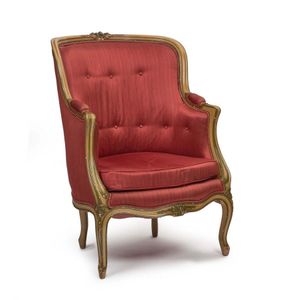Diana Mystery Clock with Blue Enamel Spherical Globe
A 19th century spelter bronze Diana figured conical pendulum mystery clock, the goddess Diana with her bow and a quiver of arrows stands with her right arm raised and holding an ormolu bracket from which is suspended on three chains a blue enamel spherical clock. The hours are indicated by affixed brass Roman numerals, with brass hands, the escapement appears as a vane on the top of the globe and is actioned against a steel pointer suspended from the bracket above. All raised on a neoclassical plinth base with arched break front to conform with the suspended position of the globe. Height 11 cm.
You must be a subscriber, and be logged in to view price and dealer details.
Subscribe Now to view actual auction price for this item
When you subscribe, you have the option of setting the currency in which to display prices to $Au, $US, $NZ or Stg.
This item has been sold, and the description, image and price are for reference purposes only.
- Bronze - An alloy of copper and tin, traditionally in the proportions of about 9 parts of copper to 1 part of tin.
The discovery of bronze in Western Asia in the 4th century enabled people to create metal objects which were superior to those previoulsy possible because of its strength and hardness, and it has been used throughout the world for weapons, coins, tools, statuary and other decorative items.
It is very fluid in a molten state, and its hardness, strength when set, and non-corrosive properties makes it most suitable for casting sculpture. - Pendulum - The pendulum was discovered around 1602 by Galileo Galilei, and was adopted for time keeping by the Dutch mathematician and natural philosopher, Christiaan Huygens, who excelled in astronomy, physics, and horology.
The pendulum comprises a metal rod usually of brass or steel with a metal disk, known as a bob, at the end. The movement of the pendulum is driven by weights or a spring, and as a pendulum swings in a regular arc, it was found accuracy could be controlled to within a few seconds a week.
Timekeeping can be adjusted by changing the height of the bob on the rod, making the pendulum either swing slower or faster.
The disadvantage of the pendulum was that changes in temperature also changed the length of the pendulum, interfering with the accuracy of the clock, and so in the 18th century two types of mercurial pendulums were invented which countered the movement in the steel rod.
The pendulum was the world's most accurate timekeeping technology until the invention of the quartz clock, regulated by a quartz crystal, in 1927. - Ormolu - Ormolu was popular with French craftsmen in the 18th and 19th century for ornamental fittings for furniture, clocks and other decorative items. True ormolu is gilt bronze, that is bronze that has been coated with gold using a mercury amalgam. Due to the health risks associated with using mercury, this method of creating ormolu was discontinued in France in the 1830s. A substitute was developed consisting of about 75% copper and 25% zinc, however it was inferior to the bronze version. It was often lacquered to prevent it tarnishing.
- Spelter - Spelter was the name given to an alloy of zinc and brass or copper used in the 19th century for statuary and lighting. It is a brittle bluish-white metal. It was used as a cheap replacement for bronze, but being brittle easily breaks and can't be repaired. When finished it can often be mistaken for bronze, but if discreet a scratch on the base displays shows a greyish colour, the metal is spelter, if a golden colour the metal is most likely bronze.
This item has been included into following indexes:
Visually similar items

Pair of antique French andirons (2)
Sold by
in
for
You can display prices in $Au, $US, $NZ or Stg.

A Japanese Kutani bowl decorated with birds and blossom, hanging from metal chains, Meiji period, 15 cm high
Sold by
in
for
You can display prices in $Au, $US, $NZ or Stg.

A rolled rose gold carved horn brooch, carved horn with deer & foliage mounted in a rolled rose gold frame, damage to one deer & grass section, Wt 13.4grams
Sold by
in
for
You can display prices in $Au, $US, $NZ or Stg.

A pair of Louis XV painted and satin upholstered bergere, 20th century
Sold by
in
for
You can display prices in $Au, $US, $NZ or Stg.
